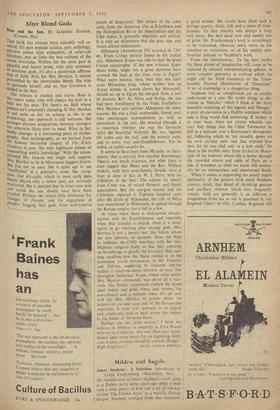After Blond Gods
Man and the Sun. By Jacquetta Hawkes. (Cresset, 30s.)
Tilts book has already been tolerably well re- ceived. It's part popular science, part anthology, selective rather than exhaustive, of solar-cult literature, and so links the two cultures of the recent brouhaha. Written for the most part in graceful and lucent prose, with only moments of feminine gush, it's also a passionate affirma- tion of faith. Evil, for Mrs. Hawkes, is almost Personified by the abominable Bomb. She tries to persuade herself, and us, that Goodness is deified in the Sun.
The venture is modest and brave. Rare is the expert today who will chance his arm in a field not his own. Yet there's no field whose Pattern isn't constantly changing. if Mrs. Hawkes
is not quite so hot on science as she is on arc not
her approach is still welcome. She
arranges discreet assignations between strangers not otherwise likely ever to meet. What in fact finally emerges is a fascinating piece of mytho- graPhy. And mythography, as we learned from the famous thirteenth chapter of The White Goddess, is now 'the only legitimate means of transmitting useful knowledge.' With the moon- oriented Mr. Graves one might well suppose Mrs. Hawkes to be at Myceruran daggers drawn. But I'm not so sure. She is quite apt to use Apollonian' in a pejorative sense. She recog- nises that sky-cults, which in most early pan,. theons played only a minor part, are variously Motivated. She is puzzled that in zones now arid
and torrid the sun should once have been extolled
changes Peoples,
Perhaps she makes little allowance for of climate; and for migrations of hugging their gods, from well-watered points of dispersion? Her review of the solar cults, from the Sumerian Uta at E-babbara and the Heliopolitan Re to the Amerindians and the Lido today, is generally objective and critical. It is only on Akhenaten that she goes nap, and waxes almost sentimental.
Akhenaten (Amenhotep IV) acceded in 1367 BC. From Cretan pottery found in his capital city, Akhetaten, Evans was able to date the great Cretan catastrophe. If the new volcanic hypo- thesis holds, might not a great darkness have covered the land at the time, even in Egypt? What more natural, then, than that this half- caste Mitannian king, whose mother was an Aryan blonde (a scarab shows her blue-eyed), should set up in Egypt the sun-god Aten, a sort of demotic Re? As Mitra and Surias, the sun had been worshipped by his Vedic forefathers. Mrs. Hawkes also idolises Akhenaten for other reasons. He was a frail, motherable, liberal soul, who encouraged expressionism as well as naturalism in the arts. He married (though it is uncertain whether she was his favourite wife) the beautiful Nefertiti. He was 'against the scales and the rod,' and the priestly caste, and in every way anti-Establishment. Yet he failed, as cranks usually do.
It seems to have been from Mycenat, or there- abouts, that a sun-cult first reached Stonehenge, There's not much evidence, but what there is does suggest that Blake and the. Rev. William Stukely, with their semi-Semitic Druids, were at least as close to fact as W. J. Perry with his `Children of the Sun.' The culture we inherit from Crete was of mixed Oriental and Greek antecedents. But the sun-god waned, and the Christians replaced it. Eighteen hundred years after the death of Akhenaten, the cult of Mitra was resuscitated in Mithraism. It spread through the Roman empire; but it fell to a Jew.
At times when there is widespread dissatis- faction with the Establishment, and especially when that includes a church, there is a temp- tation to go whoring after strange gods. Mrs. Hawkes is not a heretic but, like Julian, whom she also admires, an apostate. Does she hope to infiltrate the CND marchers with her neo-. Mithraic religious faith, so that they converge on Stonehenge to glorify Sol Invictus? One can't help recalling how the Nazis cashed in on the homespun youth movements of the Twenties and Thirties, supplying to innocent son-tan nudists a reach-me-down uniform of race. The aboriginal barbarian Aryan, whose solar deities Mrs. Hawkes commends, was above all a race- snob. The Nordic component exalted the blond ideal (white and gold, wheat and bronze,' the sun-colours) and a militant 'ethos. It's all very well for Mrs. Hawkes to prattle about the balance of yin and yang and of the Zoroastrian opposites. A solar cult, pursued to its logical end, could only lead us back across the steppes to the limbo of Mohenjo-Daro.
Perhaps she isn't quite serious? I think she believes in Mithras as sincerely as Ezra Pound believes in Confucius. Sun and Man may never- theless open many doors for an exploring mind, even if some of them should be marked 'Danger:


































 Previous page
Previous page